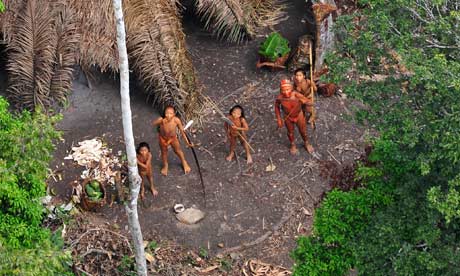The last stand of the Amazon
Posted by Big Gav in amazon
The Guardian has a report on the threat the oil and gas industry poses to the Amazon rainforest - The last stand of the Amazon.
In the past few months, the Amazon has made a return to the news for several reasons. In February, startling aerial footage of uncontacted tribes on the Brazil-Peruvian border, brought to us via the great Brazilian anthropologist, José Carlos dos Reis Meirelles, was released (you may have seen the footage on the BBC's Human Planet). A subsequent letter from the Peruvian government "recognised the situation of the peoples living in isolation and/or initial contact" and promised, for the first time, that five new reserves for indigenous communities were "in the pipeline". We shall see…
In March, three tribal leaders arrived in London to make their case against several huge hydroelectric dams being built in Brazil and Peru, which they argue will force their people from the land and threaten their way of life. And within the past few weeks, Peruvian security forces have launched an unprecedented operation to destroy the unlawful gold-mining dredgers that are now killing off river habitats by pumping up river-silt.
Part of the reason we struggle to understand the region is that there is so much to take in. And because there has been some (partial) good news on the headline problem – deforestation – it has faded in our collective consciousness in the past few years. So it's worth stepping back and reminding ourselves of some of the fundamentals.
The area of the Amazon rainforest – roughly 2.3m square miles – is larger than Western Europe and the forest stretches over nine countries: Brazil, Peru, Colombia, Bolivia, Ecuador, French Guyana, Guyana, Surinam and Venezuela. There are approximately 1,250 tributaries that service the main river, 17 of which are more than 1,000 miles long. The river is bigger in volume than its six nearest rivals combined and discharges into the ocean about 20% of the total freshwater of all the rivers in the world. Roughly a fifth of the earth's oxygen is produced in the Amazon rainforest ("one breath in five" as a guide once put it to me) and more than two-fifths of all the species in the world live there. You can find over 200 species of tree in a single hectare of Amazon rainforest and one tree can be home to 72 different species of ants alone. Over its 4,000-mile length, no human bridge crosses the Amazon river.
Ignorant as I was, the most surprising discovery when I first visited was that oil is one of the main resurgent threats to the region. Since my first visit to Peru in 2003, the amount of land that has been covered by oil and gas concessions has increased fivefold – almost 50% of the entire Peruvian-owned Amazon. This means that the government has effectively sold off half of the rainforest it owns for the specific purpose of oil and gas extraction in return for taxes, bonuses, royalties – 75% is forecast by 2020.
Every time there is oil exploration, there is major disruption and destruction to the forest, starting with seismic testing and following through with helicopters, roads, oil wells, crews and so on; each development brings a chaos of unplanned settlement and more deforestation. And inevitably, whenever oil is found there are catastrophic spills and accidents. A lawsuit is being brought to court by members of the indigenous Achuar tribe for contaminating the region. Health studies have found that 98% of their children have high levels of cadmium in their blood, and two-thirds suffer from lead poisoning.






